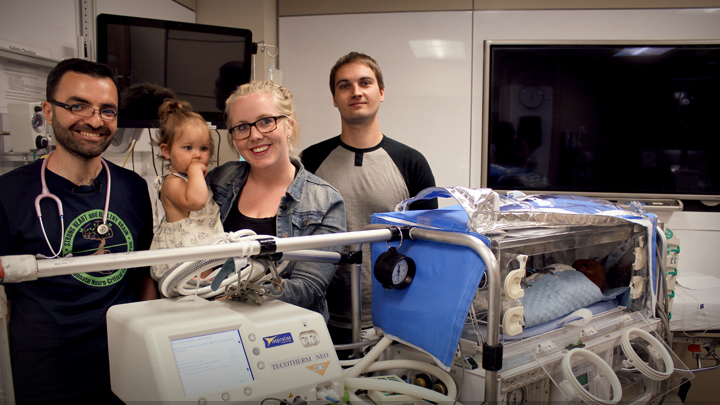
July 27, 2016

Neonatologist Dr. Khorshid Mohammad shares a smile with mom Katie Kaminski, baby Tegan de Vries and dad Curtis de Vries over the portable transportation cooling device which likely saved Tegan’s life after her birth a year ago.
Story & photo by Gregory Harris
CALGARY — Tegan de Vries took her very first steps one year to the day after she had been cooled for 72 hours in the Neonatal Intensive Care Unit at Foothills Medical Centre.
Doctors gave Tegan the cold start in life in an effort to save her from what could have been catastrophic neurological damage. The newborn lost a lot of blood during delivery by emergency caesarean section at Peter Lougheed Centre and had difficulty breathing.
“We were so lucky,” recalls mom Katie Kaminski. “The cooling probably saved her life.”
Foothills Medical Centre is now one of the first care facilities in the country to have a portable transportation cooling device, which is expected to be more reliable in maintaining needed temperatures during transport than current methods.
In current practice, babies who are deprived of oxygen at birth and born away from an advanced care facility are kept cool on transport either by turning off heating sources (passive cooling) or surrounding them with cooling gel packs.
“With those methods, it can be difficult to maintain a stable temperature,” says neonatologist Dr. Khorshid Mohammad, the neonatal neuro-critical care project lead who spearheaded the purchase of the transportation cooling device.
“The period immediately following birth is critical. We have about a six-hour window to lower these babies’ temperatures to prevent neurological damage. The sooner we can do so, and the more consistent we can make the temperature, the more protective it is and the better their chances of surviving without injury.”
Therapeutic hypothermia, a process in which cooling blankets and other devices are used to lower a newborn’s temperature to 33.5 degrees for three days, helps protect fragile brain tissue and promote recovery. (Normal body temperature is about 37 degrees.)
The new transportation cooling unit will be installed on a portable incubator cart that can be dispatched with a care team anywhere in southern Alberta, either by ground or air.
Today Tegan is a healthy, bubbly 13-month-old and ahead of her developmental milestones.
“We’re so grateful for the care she received,” Kaminski says. “Dr. Mohammad and the team of doctors and nurses in the NICU were so amazing — we owe them her life.”
Tegan, Katie and Tegan’s dad Curtis de Vries have since raised money and supplies for the Foothills NICU.
If the transportation cooling device proves as effective as doctors anticipate, Dr. Mohammad says his group will share the results with other referral hospitals in the province for consideration.
About 65 per cent of babies are born outside facilities that have neonatal intensive care units, where care providers have the capability to implement therapeutic hypothermia.
The NICUs at Foothills Medical Centre and Alberta Children’s Hospital are also among the first centres in Canada to monitor cooled babies with continuous video EEG (electro- encephalogram), so doctors can respond to seizures that might not be outwardly visible.
In Calgary, about 40 newborns undergo therapeutic hypothermia every year. Of the approximately 50,000 babies born in Alberta each year, about 500 term and near-term babies are at risk of brain injury due to oxygen deprivation around the time of delivery, despite careful monitoring.
The neonatal neuro-critical care team in Calgary is working on standardizing care guidelines for babies at risk. These will include practices such as therapeutic hypothermia, as well as other protective strategies starting from pregnancy all the way to followup in a specialized clinic at Alberta Children Hospital.
The cost of the transportation cooling device is $35,000. It and the new Neuro-Critical Care program are made possible by community donations through the Alberta Children’s Hospital Foundation.